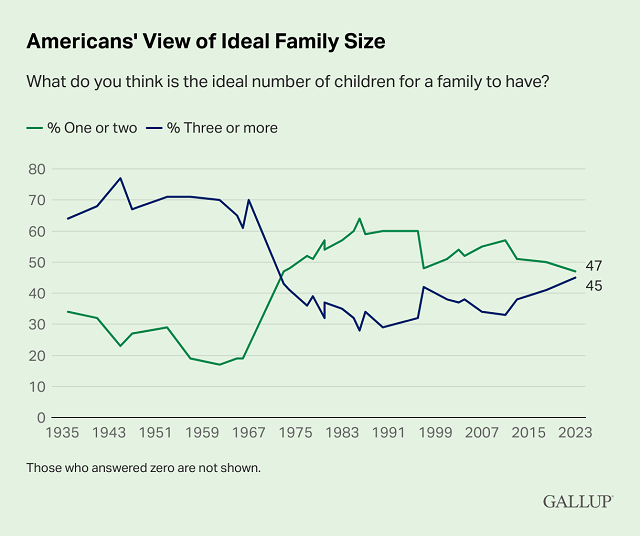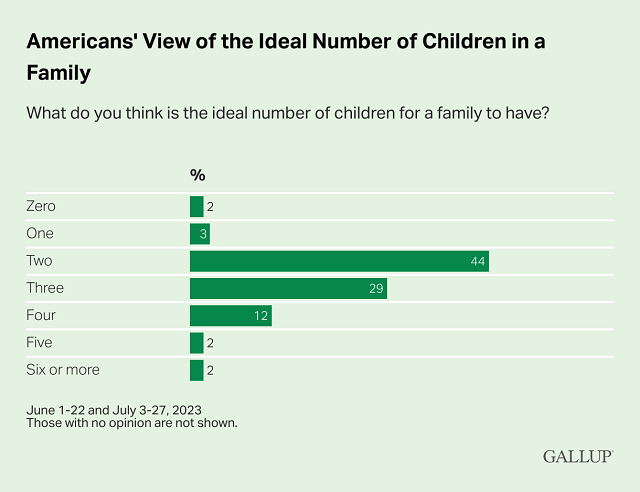Highlights
- Today, 45% of Americans see three or more children as ideal, a steep increase from 38% in 2013 and from 33% in 2003. Post This
- While the desire for larger families is increasing, birth rates are on a downward trend. Post This
- The percentage of Americans who favor smaller families of two children or one child has trended downward over the last two decades. Post This
The desire for larger families is back in vogue in America. But will that wish be fulfilled?
Not since the sweeping social changes of the late 1960s have more Americans considered a larger family of three or more children ideal, Gallup revealed today in its latest Social Series survey on the ideal number of children. While the preference for larger families has seen a slow and steady increase over the last several years, new Gallup poll numbers show the highest percentage point in 50 years. Today, 45% of Americans see three or more children as ideal, a steep increase from 38% in 2013, and an even wider gap from 33% in 2003.
Conversely, the percentage of Americans who favor smaller families of two children or one child has trended downward over the last two decades. Today, 47% of American adults prefer a smaller family, down from 53% a decade ago, and 55% in 2003.

Just 2% of Americans favor having no children.
For those who prefer a larger family, most (29%) consider three the right number, while 12% raise their ideal number to four. An additional 2% say five is best, and the remaining 2% say six or more children is the ideal family size. Among those who favor a smaller family, most (44%) say two children is just right while 3% say one is enough.
On average, Americans' ideal number of children is 2.7, the highest reported desired number of children since 1980. But 2.7 children is still about one child more than the current U.S. fertility rate of 1.8 births per woman.

There’s a clear mismatch between Americans' desire for children and the number of children a woman has before the end of her fertile years. While the desire for larger families is increasing, birth rates are on a downward trend.
Young Americans are having their first child later than ever. The CDC reports the mean age in 2021 for a woman at first birth was 27.3, a record high due to a decrease in first births for women in their teens and twenties and increase in births for women in their 30s and 40s. While young Americans are the largest cohort (52%) to say a larger family is ideal, Gallup reports just 21% of Americans ages 18-29 are parents, Young Americans are also more likely (16%) to say they never want children.
Gallup reports that 74% of American men and women ages 30 to 49 have at least once child, while another 11% still hope to have a child, and 6% wish they’d had children. Just 8% do not want to have children.
On the other hand, more women than ever are giving birth in their forties. The CDC reported earlier this year that in 2022, the birth rate for women ages 40-44 increased by 4%, and the number of births by 6% from the previous year. Women ages 45-50 saw an increased birth rate of .09% while the number of births rose 12% from 2021.
So, what’s going on here? According to Gallup, the desire for larger families dropped precipitately in 1971 from 70% in 1967 to just over half (52%)—a decrease that could be explained by the advent of the contraceptive pill, more women entering the workforce, and Paul Erlich’s 1968 bestseller, The Population Bomb.
Today, we have a similar trend with the rise of anti-natalism where its nihilistic supporters believe the world is too sad a place to bring children into, along with climate change “doomerism.” More practically, the current economy makes family forming more challenging for many young Americans. Then again, those earning less than $40,000 are more likely (51%) to say a larger family is ideal than those who earn $40,000-$100,000 (43%) and those earning over $100,000 (42%).
The answer is much less complicated. Women are more likely to want to be in a committed relationship, ideally a marriage, before having children. Women today are marrying later than ever at age 28.5 on average. As I’ve written here before, most childless women yearn to have children or grieve not having had them. They are childless by circumstance, not choice.
Most women eventually become mothers, and men become fathers, even if it happens decades later than they intended. They are just not having the number of children they want. What is leading to Americans' unfilled desires?
“The decline in fertility is mostly due to declining marriage,” Lyman Stone wrote in this space back in 2018 when Gallup released a similar study. “Women who get married are overwhelmingly more likely to achieve their childbearing ideals and expectations…as I have shown before,” Stone explained. “Thus, any debate about fertility has to begin with the question of why marriage is being delayed.”
For this, I leave you with IFS’s own Brad Wilcox and his upcoming book: Get Married: Why Americans Must Defy the Elites, Forge Strong Families, and Save Civilization. While finding love and marriage may not be easy, the growing number of Americans hoping for a larger brood should make it their priority.
Melanie Notkin is the author of OTHERHOOD: Modern Women Finding a New Kind of Happiness, and founder of SAVVY AUNTIE: A Celebration of Modern Aunthood.












